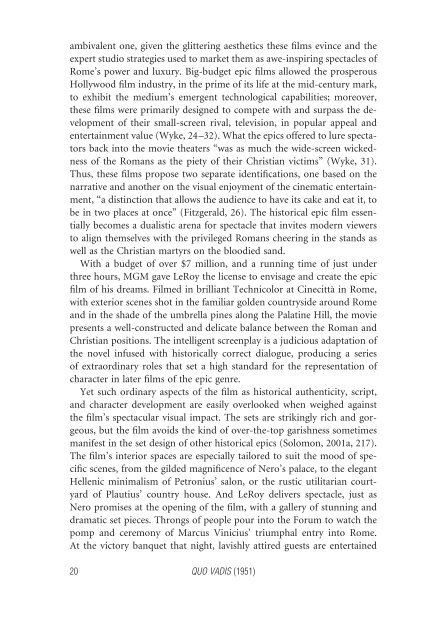Big Screen Rome - Amazon Web Services
Big Screen Rome - Amazon Web Services
Big Screen Rome - Amazon Web Services
Create successful ePaper yourself
Turn your PDF publications into a flip-book with our unique Google optimized e-Paper software.
ambivalent one, given the glittering aesthetics these films evince and the<br />
expert studio strategies used to market them as awe-inspiring spectacles of<br />
<strong>Rome</strong>’s power and luxury. <strong>Big</strong>-budget epic films allowed the prosperous<br />
Hollywood film industry, in the prime of its life at the mid-century mark,<br />
to exhibit the medium’s emergent technological capabilities; moreover,<br />
these films were primarily designed to compete with and surpass the development<br />
of their small-screen rival, television, in popular appeal and<br />
entertainment value (Wyke, 24–32). What the epics offered to lure spectators<br />
back into the movie theaters “was as much the wide-screen wickedness<br />
of the Romans as the piety of their Christian victims” (Wyke, 31).<br />
Thus, these films propose two separate identifications, one based on the<br />
narrative and another on the visual enjoyment of the cinematic entertainment,<br />
“a distinction that allows the audience to have its cake and eat it, to<br />
be in two places at once” (Fitzgerald, 26). The historical epic film essentially<br />
becomes a dualistic arena for spectacle that invites modern viewers<br />
to align themselves with the privileged Romans cheering in the stands as<br />
well as the Christian martyrs on the bloodied sand.<br />
With a budget of over $7 million, and a running time of just under<br />
three hours, MGM gave LeRoy the license to envisage and create the epic<br />
film of his dreams. Filmed in brilliant Technicolor at Cinecittà in <strong>Rome</strong>,<br />
with exterior scenes shot in the familiar golden countryside around <strong>Rome</strong><br />
and in the shade of the umbrella pines along the Palatine Hill, the movie<br />
presents a well-constructed and delicate balance between the Roman and<br />
Christian positions. The intelligent screenplay is a judicious adaptation of<br />
the novel infused with historically correct dialogue, producing a series<br />
of extraordinary roles that set a high standard for the representation of<br />
character in later films of the epic genre.<br />
Yet such ordinary aspects of the film as historical authenticity, script,<br />
and character development are easily overlooked when weighed against<br />
the film’s spectacular visual impact. The sets are strikingly rich and gorgeous,<br />
but the film avoids the kind of over-the-top garishness sometimes<br />
manifest in the set design of other historical epics (Solomon, 2001a, 217).<br />
The film’s interior spaces are especially tailored to suit the mood of specific<br />
scenes, from the gilded magnificence of Nero’s palace, to the elegant<br />
Hellenic minimalism of Petronius’ salon, or the rustic utilitarian courtyard<br />
of Plautius’ country house. And LeRoy delivers spectacle, just as<br />
Nero promises at the opening of the film, with a gallery of stunning and<br />
dramatic set pieces. Throngs of people pour into the Forum to watch the<br />
pomp and ceremony of Marcus Vinicius’ triumphal entry into <strong>Rome</strong>.<br />
At the victory banquet that night, lavishly attired guests are entertained<br />
20 QUO VADIS (1951)



